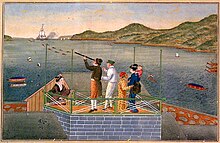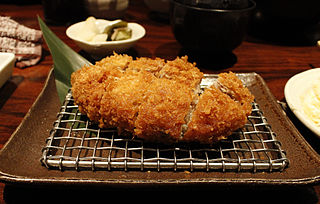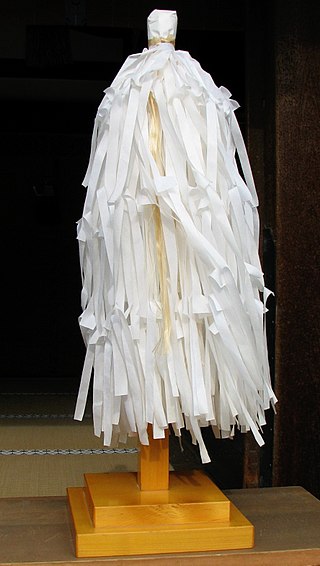
Japanese words of Dutch origin started to develop when the Dutch East India Company initiated trading in Japan from the factory of Hirado in 1609. In 1640, the Dutch were transferred to Dejima, and from then on until 1854 remained the only Westerners allowed access to Japan, during Japan's sakoku seclusion period.
Contents
Numerous exchanges occurred, leading to a branch of Western learning in Japan known as rangaku (蘭学), or "Dutch learning", where the ran (蘭, "Dutch") in rangaku comes from Oranda, the Japanese word for Holland; gaku (学) is of Sino-Japanese origin and means "learning". [1] In the process, a number of terms were adopted from Dutch into the Japanese language. At one point, some 3,000 words are thought to have been used, especially in the areas of technical and scientific vocabulary. [1] About 160 such words of Dutch origin remain in use today in standard Japanese. [1]
| Japanese transliteration ( rōmaji ) | Japanese term (kanji or kana) | original Dutch term | English translation of Dutch | Meaning of Japanese term | Details |
|---|---|---|---|---|---|
| arukari [2] | アルカリ | alkali | alkali | alkali | From Arabic, through Dutch. |
| arukōru [1] | アルコール | alcohol | alcohol | alcohol (chemistry), alcoholic drink [3] [4] | From Arabic, through Dutch. |
| asubesuto [2] | アスベスト | asbest | asbestos | asbestos | From Greek, through Dutch. |
| bīru [5] | ビール, 麦酒 | bier | beer | beer | |
| bisuketto [1] | ビスケット | beschuit | biscuit | biscuit | Reinforcement of Portuguese biscoito. |
| bōru [1] | ボール | boor | bore | drill, bore | After 1720. |
| buriki [2] | ブリキ | blik | tin (can) | tinplate [6] | |
| chifusu [2] | チフス | tyfus | typhus | typhus | From Greek, through Dutch. |
| chinki [2] | チンキ | tinctuur | tincture | tincture | Shortened from チンキテュール (chinkityūru). |
| dansu | ダンス | dans | dance | dance | |
| doitsu | ドイツ | Duits | German | Germany | |
| dokku | ドック | dok | dock | dry dock | Also a contraction of ningen dokku ( ja:人間ドック , (literary: human dry dock) routine physical examination). |
| dontaku [1] | ドンタク | zondag | Sunday | Sunday | Also occasionally found as ゾンタク (zontaku). Appears from the early Meiji period, after 1868. (As of 2021 [update] ) usage reduced to specific terms e.g. Hakata Dontaku. |
| doronken [2] | ドロンケン | dronken | drunk | drunk | obsolete |
| ekisu [2] | エキス | extract | extract | extract | Shortened from エキストラクト (ekisutorakuto). |
| erekishiteito [1] | エレキシテイト | elektriciteit | electricity | electricity | Obsolete, replaced by denki (電気). |
| erekiteru [2] | エレキテル | corruption of elektriciteit | electricity | elekiter | A type of electrostatic generator used for electric experiments in the 18th century. |
| ēteru [1] | エーテル | ether | ether | ether, aether | From Greek, through Dutch. "Ethernet" is pronounced īsanetto from English. |
| garasu [5] | ガラス, 硝子 | glas | glass (of a window) | glass (the material) | |
| gasu [2] | ガス, 瓦斯 | gas | gas | gas | |
| giyaman [1] | ギヤマン | diamant | diamond | diamond, glass (the material) | Obsolete. From Greek, through Dutch. |
| gomu [1] | ゴム | gom, gum | rubber | rubber | |
| gorofukuren [2] | ゴロフクレン, 呉絽服連 | grofgrein | grosgrain | grosgrain | Obsolete |
| hamu [1] | ハム | ham | ham | ham | |
| handon | 半ドン, ハンドン | zondag | Sunday | half-day; holiday | Compound of Japanese han (half) and dontaku (< zondag). This word is no longer commonly used in Japanese. |
| hatoron [2] | ハトロン, パトロン | patroon | cartridge (firearms) | cartridge case (firearms) [7] | Obsolete. Only remain in hatoronshi ( ja:ハトロン紙 , kraft paper). |
| henrūda [2] | ヘンルーダ | wijnruit | common rue | common rue | |
| hetto [2] | ヘット | vet | fat | beef tallow | Cognate with English fat . |
| hisuterii | ヒステリー | hysterie | hysteria | hysteria | |
| hokku [1] [8] | ホック | hoek | hook | hook | Cognate with English hook . |
| infuruenza [1] | インフルエンザ | influenza | influenza | influenza | After 1720. More likely borrowed from English. The term originated in Italian, and became common worldwide in the 18th century via English. |
| inki [2] | インキ | inkt | ink | ink | |
| kamitsure [1] | カミツレ | kamille | camomile | camomile | From Greek, through Dutch and Chinese. The medial -tsu appears due to the Japanese reading of the Chinese spelling 加密列. [9] After 1720; first imported in 1818, and first attested in 1822. [9] |
| kantera [2] | カンテラ | kandelaar | candlestick | kerosene lamp | |
| kapitan [1] | カピタン, 甲比丹 | kapitein | captain | (obsolete: captain), chief of Dutch East India Company's post in Japan [10] | More likely derived from Portuguese capitão . [10] |
| karan | カラン | kraan | tap (UK) / faucet (Am.) | tap (UK) / faucet (Am.) | Cognate with English crane , from the resemblance of the bird's neck to a faucet pipe. |
| kari [2] | カリ, カリウム | kali, kalium | potassium | potassium | |
| karuki [2] | カルキ | kalk | lime (the chemical), chlorinated lime | lime (the chemical), chlorinated lime | Cognate with English chalk . |
| katēteru [2] | カテーテル | katheter | catheter | catheter | From Greek, through Dutch. |
| kechin [1] | ケチン | ketting | chain | chain | After 1720. Now obsolete (replaced by 鎖 (kusari)). |
| keido [11] | 珪土 | keiaarde | silica | silica | Calque. The initial element kei is a phonetic borrowing from the kei in the Dutch term keiaarde, and the do in the Japanese (土, “earth, soil”) is a translation of the aarde (“earth, soil”) of the Dutch term. First appears in 1877. Now obsolete, replaced by シリカ (shirika) from English silica . |
| kiruku / koruku [2] | キルク / コルク | kurk | cork | cork | |
| kōhī [5] | コーヒー, 珈琲 | koffie | coffee | coffee | From Arabic, through Dutch. |
| kokku [2] | コック | kok | cook | chef [12] | |
| koppu [1] | コップ | kop | cup | cup | Reinforcement of Portuguese copo. |
| konpasu [1] | コンパス | kompas | compass | compass | |
| korera [2] | コレラ | cholera | cholera | cholera | From Greek, through Dutch. |
| kureosōto [2] | クレオソート | creosoot | creosote | creosote | |
| madorosu [1] | マドロス | matroos | sailor | sailor | |
| masuto [1] | マスト | mast | mast | mast | |
| mesu [1] | メス | mes | knife | scalpel | After 1720. |
| moruhine [1] | モルヒネ | morfine | morphine | morphine | After 1720. |
| morumotto [13] | モルモット | marmot | marmot | Guinea pig | |
| nisu [14] | ニス | vernis | varnish | varnish | |
| oburāto [2] | オブラート | oblaat | wafer | oblaat [15] | Also listed in some Japanese sources as deriving from the cognate German term Oblate . [15] |
| orugōru [5] | オルゴール | (orgel) muziekdoos | (organ) music box | (organ) music box | |
| penki [13] | ペンキ | pek, pik | house paint | house paint | |
| pesuto [1] | ペスト | pest | black death | black death | After 1720. |
| pinto [13] | ピント | punt | focus | focus | Shortened from the longer term brandpunt . |
| pisutoru [5] | ピストル | pistool | pistol | pistol | |
| ponpu [1] | ポンプ | pomp | pump | pump | After 1720. |
| ponzu [2] | ポン酢 | pons | ponzu | The Dutch term pons for the beverage was already obsolescent by 1864, [16] and was eventually superseded by the term punsch or punch . | |
| randoseru [2] | ランドセル | ransel | backpack | randoseru | From German Ränzel or Low German rensel, through Dutch. |
| ranpu [2] | ランプ, 洋灯 | lamp | lamp | lamp | From Greek, through Dutch. |
| retoruto [2] | レトルト | retort | retort | retort, retort pouch | |
| renzu [2] | レンズ | lens | lens | lens | |
| safuran [2] | サフラン | saffraan | saffron | saffron | |
| saten [2] | サテン | satijn | satin | satin | |
| seimi [2] | セイミ, 舎密 | chemie | chemistry | chemistry | Now obsolete, replaced by kagaku ( 化学 ). |
| shian [2] | シアン | cyaan | cyan | cyan | |
| shiroppu [2] | シロップ | siroop | syrup | syrup | |
| sukoppu [13] | スコップ | schop | trowel | trowel | Cognate with English scoop . |
| supoito [2] | スポイト | spuit | syringe | syringe | Cognate with English spout . |
| tarumomētoru [1] | タルモメートル | thermometer | thermometer | thermometer | From French, through Dutch. After 1720. Now obsolete; replaced by taionkei ( 体温計 ). |
| teresukoppu [1] | テレスコップ | telescoop | telescope | telescope | From Italian and Modern Latin, through Dutch. After 1720. Replaced by bōenkyō ( 望遠鏡 ). |
| yojiumu [2] | ヨジウム | jodium | iodine | iodine | Now transformed into yōso ( ja:ヨウ素 , iodine). |
| zukku [2] | ズック | doek | canvas | canvas, canvas shoes [17] | Both Japanese zukku and English duck (“piece of cloth”) are borrowings from Dutch doek . [18] |










